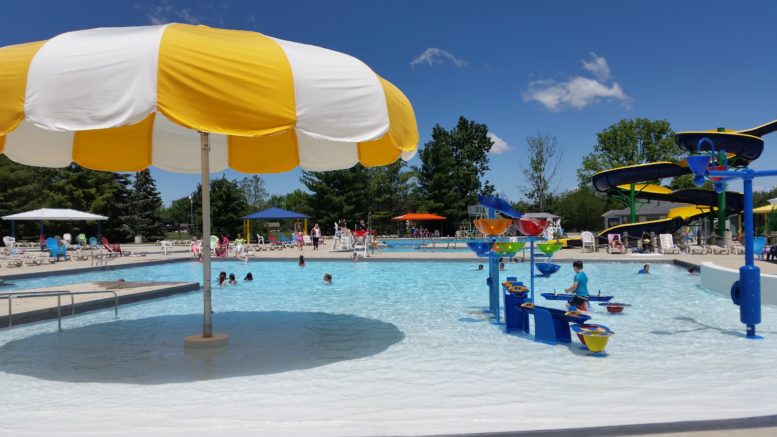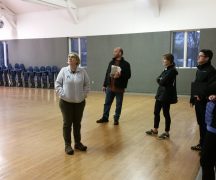By JAN LARSON McLAUGHLIN
BG Independent News
In an effort to keep poo out of the pool, all children in diapers will now be required to wear reusable swim pants at the Bowling Green City Pool.
Disposable swim diapers have been required in the past, but they tend to fill up with water as soon as children enter the pool – leaving no saturation for leaks from swimmers who aren’t potty trained.
“They don’t contain the fecal matter very well,” Parks and Recreation Director Kristin Otley said Tuesday during a meeting of the city’s parks and recreation board.
Fitness and aquatic manager Josh Chatfield was more descriptive.
“Poop escapes the diapers – up the back,” he said, eliciting some groans from the board.
Otley and Chatfield said the swimming pool will provide free reusable swim pants for parents of diapered children. The Bowling Green Community Foundation is providing a $2,440 grant to purchase about 1,000 of the swim pants.
The cost of the poop-trapping pants is far less than the cost of treating feces that reaches the pool water.
Treating escaped excrement varies per incident, and can take as long as 24 hours to complete. The costs for the chemicals, staff time for clean up, and lost revenue due to closure range from $750 to $3,625 per fecal incident.
The Bowling Green pool experiences an average of six stools in the pool each summer. In addition to being costly to resolve, feces in the water is a public health issue. Waterborne illnesses, such as Giardia and Cryptosporidium, can spread quickly if the waste goes unnoticed or unreported.
Then there is the negative image associated with swimming in water contaminated by fecal matter.
The reusable swim pants will be available on-site along with public health information about illnesses that can result from contamination of the water. Otley and Chatfield explained that they want the swim pants to be free, since many families will arrive to swim for the day and be unaware of the new rule.
Additionally, there could be a financial barrier for many underprivileged and unprepared families that could lead to them being turned away because they do not have a reusable swim diaper.
The swim pants can be taken home by families, and reused when they return to the pool.
The board also discussed other pool-related matters Tuesday evening. Otley gave an update on the pool budget and presented a proposal to bring in more revenue.
In November, the board was informed that while swimmers swarmed the pool last summer, revenues took a plunge due to increased costs to operate the site.
While the city saw increased numbers of people flocking to the pool, any revenue growth from the jump in attendance was gobbled up by increased expenses for staff, chemicals, concessions and natural gas.
So when it was all tallied up at the close of the season, the pool budget ended up $29,230 in the red – with $326,085 in revenue and $355,315 in expenses.
The city had already dedicated $20,000 in American Rescue Plan funding to the pool, so that brought the expenses to $9,230 over budget.
And that funding will not be repeated.
“There are no ARPA funds coming this year,” Otley said.
Otley suggested that the daily fee for non-residents be increased 50 cents. That would bring in an estimated $6,000 more this summer. She recommended that rates for city residents remain unchanged, since residents already pay toward the pool through taxes.
The last rate increase at the pool occurred in 2019 – again just for non-residents.
Two board members – Cale Hover and Ardy Gonyer – questioned whether the proposed increase would be enough. Otley said the uncertainty surrounding the economy makes her hesitant to recommend more.
“There’s quite a lot of economic uncertainty,” she said.
The board will discuss the rates again in February before making a decision. The board’s recommendation will then go to City Council for a vote.
The numbers presented for the pool in November weren’t all negative. On the bright side, the daily pool admissions were high – bringing in $136,235, nearly $20,000 more than the previous year. Season passes, however, took a dip – totaling $95,068, nearly $12,000 less than the previous year.
Concession sales were high – coming in at $69,539, about $6,000 more than in 2021.
And swimming lessons were solid, with revenue of $25,243, about $900 less than the previous year, despite the decision to drop the maximum class size from 18 to 12 to provide for better instruction and more individual attention for students.
Overall, the revenues were up about 3.6%.
However, the expenses for supplies, staffing and deliveries shot up about 7.7%, or $25,552 more than the previous year.
Those expenses included administration and maintenance staff up about $2,000, aquatic staff up around $5,000, chemicals increased by $4,000, concession supplies by nearly $3,000, operating expenses by $9,000, and natural gas by more than $3,000.




